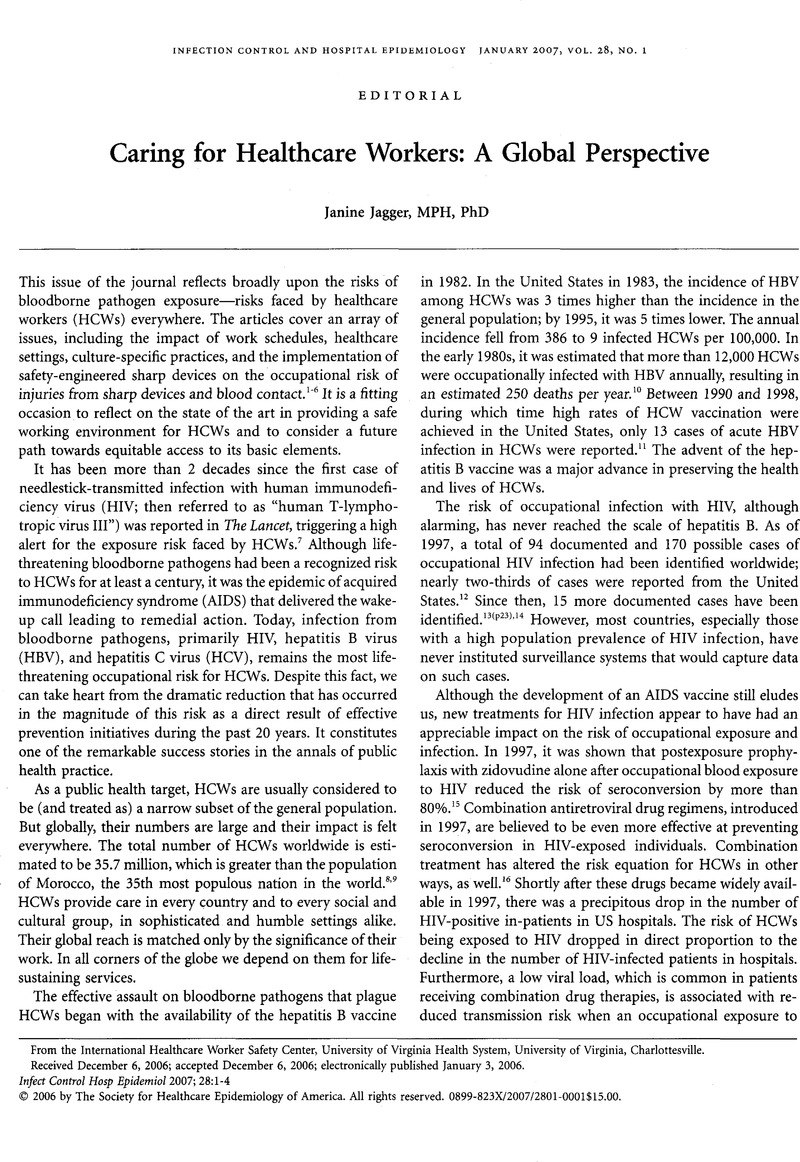Crossref Citations
This article has been cited by the following publications. This list is generated based on data provided by Crossref.
Phillips, Elayne Kornblatt
Owusu-Ofori, Alex
and
Jagger, Janine
2007.
Bloodborne Pathogen Exposure Risk Among Surgeons in Sub-Saharan Africa.
Infection Control & Hospital Epidemiology,
Vol. 28,
Issue. 12,
p.
1334.
Johnson, Cheryl L.
DeMass Martin, Suzanne L.
and
Markle-Elder, Sara
2007.
A National Solution to Patient Handling Injuries.
AJN, American Journal of Nursing,
Vol. 107,
Issue. 9,
p.
73.
Trimmer, Anne
2008.
In support of a national call to action for mandated use of safety engineered medical devices and improved surveillance.
Healthcare infection,
Vol. 13,
Issue. 4,
p.
109.
Jagger, Janine
2008.
Fine points about safety syringes and level of risk.
American Journal of Infection Control,
Vol. 36,
Issue. 7,
p.
501.
2008.
Protecting health professionals, our most precious resource.
International Nursing Review,
Vol. 55,
Issue. 1,
p.
1.
HOLZEMER, William L.
2008.
HIV infection: Fear of contagion, reality of risk.
Japan Journal of Nursing Science,
Vol. 5,
Issue. 1,
p.
5.
Doe, Jane
Perry, Jane
Gomaa, Ahmed
Jagger, Janine
Care, Emergency
and
Institute, Research
2009.
Handbook of Modern Hospital Safety, Second Edition.
p.
1.
Kim, Eun-A
2010.
Occupational Diseases of Health Care Workers.
Hanyang Medical Reviews,
Vol. 30,
Issue. 4,
p.
265.
Deuffic-Burban, S.
Delarocque-Astagneau, E.
Abiteboul, D.
Bouvet, E.
and
Yazdanpanah, Y.
2011.
Blood-borne viruses in health care workers: Prevention and management.
Journal of Clinical Virology,
Vol. 52,
Issue. 1,
p.
4.
Liyanage, Isurujith
Caldera, Tskrd
Rwma, Rajapaksha
Liyange, C.
Silva, Pubudu
and
Karunathilake, I.
2012.
Sharps injuries among medical students in the faculty of medicine, Colombo, Sri Lanka.
International Journal of Occupational Medicine and Environmental Health,
Vol. 25,
Issue. 3,
Kiliç Akça, Nazan
Başer, Mürüvvet
and
Gül Kuzucu, Emine
2013.
Knowledge and attitudes of emergency nurses towards Crimean–Congo haemorrhagic fever in endemic regions of Turkey.
International Journal of Nursing Practice,
Vol. 19,
Issue. 6,
p.
603.
Gyawali, Sudesh
Rathore, Devendra S
KC, Bhuvan
and
Shankar, P Ravi
2013.
Study of status of safe injection practice and knowledge regarding injection safety among primary health care workers in Baglung district, western Nepal.
BMC International Health and Human Rights,
Vol. 13,
Issue. 1,
Mitchell, A.
Spencer, M.
and
Edmiston, C.
2015.
Role of healthcare apparel and other healthcare textiles in the transmission of pathogens: a review of the literature.
Journal of Hospital Infection,
Vol. 90,
Issue. 4,
p.
285.
Jiang, Lili
Ng, Isabel Hui Leng
Hou, Yan'an
Li, Dunli
Tan, Linda Wei Lin
Ho, Hanley Jian An
and
Chen, Mark I-Cheng
2018.
Infectious disease transmission: survey of contacts between hospital-based healthcare workers and working adults from the general population.
Journal of Hospital Infection,
Vol. 98,
Issue. 4,
p.
404.
Morris, H.
and
Murray, R.
2020.
Medical textiles.
Textile Progress,
Vol. 52,
Issue. 1-2,
p.
1.



